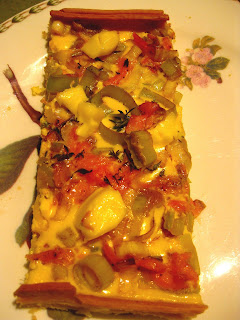But even though there were eight of us, and a smoked chicken looks quite small, I had enough chicken left over for my dinner that night and I still hadn't eaten it all. So the next day I pulled all the remaining flesh off the bones and cooked up the carcass with an onion, parsley and some juniper berries to make a delicious smoky flavoured stock. I left it in the fridge overnight, then transformed it into a spaghetti sauce for a quick dinner.
It was very good, but a little too liquid. I had deliberately cooked extra spaghetti, so I put the leftover portion into the sauce, still in its pot, and put the whole thing in the fridge.
Next night I got it out for a second dinner. The pasta seemed to have absorbed most of the sauce. I heated it up in the microwave and it was absolutely superb.
Smoked chicken and mushroom sauce for pasta
For the stock
1 smoked chicken carcass
1 onion
Parsley sprigs or one large stalk with leaves (preferably flat-leaved)
6 juniper berries
1 chicken stock cube
Bring 3 cups water to boil. Add chicken carcass, quartered onion, juniper berries and parsley. Boil gently for about 30 minutes. Watch it and if the liquid is getting low, add more boiling water. Check seasoning. Strain off stock and leave in fridge overnight. Skim off fat.
Spaghetti or fettucine
Required amount for 2-3 servings
(I find 75g is enough for one serving, but you may want more)
Cook in boiling salted water till al dente. Drain and keep warm in the hot pan while you make the sauce.
For the sauce
(Enough for 2-3 servings)
20g butter
20g plain flour
50ml dry white wine
200-250ml stock
Juice of half a lemon
4 button mushrooms, thinly sliced
About 200g leftover smoked chicken, cut into small pieces if necessary
Melt butter in small heavy based pan. Off the heat, stir in flour rapidly to avoid lumps. Cook over gentle heat for 2 minutes, storing constantly. Off the heat, stir in half the stock. If you can be bothered, heat the wine to reduce it a little then add to sauce. (I must admit, I just put it in - the sky didn't fall and it tasted fine.) Return to gentle heat and stir until it thickens. Add the lemon juice, the thinly sliced mushrooms and a little more stock and cook, stirring, until the mushrooms soften a little and it reaches the thickness you want. (If you would like to try the overnight pasta method, it should be quite runny.)
Stir in the leftover chicken and heat it through. Check seasoning. You probably won't need more salt as the smoked chicken is quite salty, but you can grind in some black or white pepper if you like.
You can eat the sauce over the pasta immediately, or you can try keeping the sauce quite thin, putting the cooked pasta in it and keeping it till the next night, then reheating it. Magnifico.




















































